| 
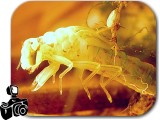 A
dragonfly starts life as an egg laid in or near water. Dragonfly
larvae, called nymphs (also naiads), are aquatic. The egg
usually hatches in 1-2 weeks. The nymph will feed and grow,
shedding its skin several times. Each stage between shedding
is called an instar. Depending on the species there can
be 8 to 17 instars, and nymphs can take from 4 weeks to
several years to grow large enough to change into adults.
The last instar will crawl out of the water, shed its skin
and emerge as a winged adult. This kind of insect life cycle
is called “incomplete metamorphosis”. A
dragonfly starts life as an egg laid in or near water. Dragonfly
larvae, called nymphs (also naiads), are aquatic. The egg
usually hatches in 1-2 weeks. The nymph will feed and grow,
shedding its skin several times. Each stage between shedding
is called an instar. Depending on the species there can
be 8 to 17 instars, and nymphs can take from 4 weeks to
several years to grow large enough to change into adults.
The last instar will crawl out of the water, shed its skin
and emerge as a winged adult. This kind of insect life cycle
is called “incomplete metamorphosis”.
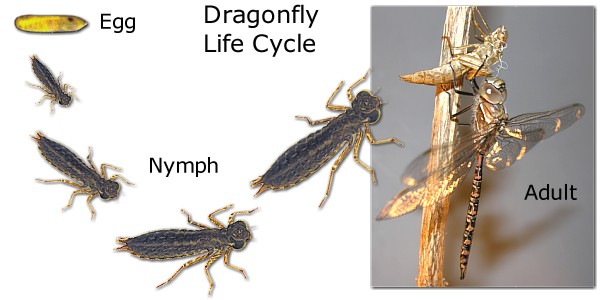
|  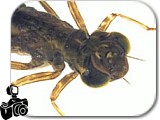 Nymphs
of damselflies breathe with 3 feather-like gills
at the tip of their abdomen and can swim by
wiggling their abdomen like a fish. Dragonfly
nymphs have gills inside their rectum at the
end of the abdomen. Muscle action moves water
in and out of the rectum. They can even jet
around by expelling water rapidly. They use
their legs to crawl around most of the time,
but can use jet-propulsion to escape enemies
and even to lunge after prey. Nymphs
of damselflies breathe with 3 feather-like gills
at the tip of their abdomen and can swim by
wiggling their abdomen like a fish. Dragonfly
nymphs have gills inside their rectum at the
end of the abdomen. Muscle action moves water
in and out of the rectum. They can even jet
around by expelling water rapidly. They use
their legs to crawl around most of the time,
but can use jet-propulsion to escape enemies
and even to lunge after prey.
|
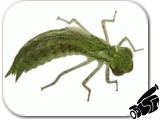
Watch a dragonfly
nymph "jetting" around. (Video
= 0:33, 1.0 Mb) |

Damselfly nymphs
swimming. (Video = 0:20, 0.5 Mb) |
| |
Watch higher resolution versions of these videos on YouTube.
Click Here: Nymph Jetting Around! | Click Here: Nymph Swimming! |
|
|
| 
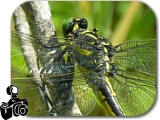 Most
Manitoba dragonflies have only one generation (from egg
to adult) per year. Some require four or more years for
one generation. Most have offsetting generations, though,
so there are always some adults around each year. Most
Manitoba dragonflies have only one generation (from egg
to adult) per year. Some require four or more years for
one generation. Most have offsetting generations, though,
so there are always some adults around each year. |
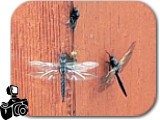 
Some dragonflies emerge at night and
are ready to fly the next morning. Other species emerge
during the day. Many species emerge in large numbers over
a very short period, often just a few hours. “Mass
emergences” ensure that males and females will mature
at the same time and find mates. They also overwhelm local
predators and ensure survival of enough breeding adults.
The synchrony of emergences in most
species and the short lifespan of adults mean that each
species has its own flight season, the time of year when
adults are hunting and mating. We see dragonflies around
from spring to early fall, but it is a series of different
species that we see, each with its own flight season of
a few weeks. No one species of dragonfly is around all
summer.
|
|
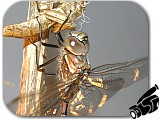 Dragonfly
emergence! Dragonfly
emergence!
(Video = 2:00, 3.7 Mb.) |
|  Most
adult dragonflies live only a few weeks. After
spending a long time, up to several years, as
a slow-moving aquatic nymph, the adult has a
short, intensely active life as an aerial hunter. Most
adult dragonflies live only a few weeks. After
spending a long time, up to several years, as
a slow-moving aquatic nymph, the adult has a
short, intensely active life as an aerial hunter.
|
|
|
| |
Watch a higher resolution version of this video on YouTube. Click Here: Emergence! |
|

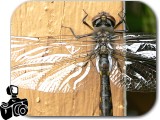 A
dragonfly can fly about an hour after it emerges, but it
takes up to two weeks before it is fully mature. A newly
emerged dragonfly is pale in colour without any dark markings.
It is called a “teneral” or immature. It will
fly off and feed until it is mature and its adult colours
have developed. Then it seeks out wetland habitat to find
a mate. A
dragonfly can fly about an hour after it emerges, but it
takes up to two weeks before it is fully mature. A newly
emerged dragonfly is pale in colour without any dark markings.
It is called a “teneral” or immature. It will
fly off and feed until it is mature and its adult colours
have developed. Then it seeks out wetland habitat to find
a mate.
|
| 
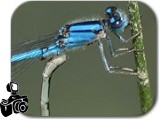 Males
wait near wetlands for females to show up. They court them
in flight, often hovering directly in front of the female.
In some species, males set up territories and drive off
rivals. Males
wait near wetlands for females to show up. They court them
in flight, often hovering directly in front of the female.
In some species, males set up territories and drive off
rivals.
Prior to mating, males transfer sperm
from the 9th abdominal segment to the hamulus, a secondary
sex organ in the 3rd segment. A male first grabs a female
with his legs and then grasps her behind her head with claspers
at the tip of his abdomen. They mate in a “wheel”
position where the female curls her abdomen up to take sperm
from the hamuls. |
| 
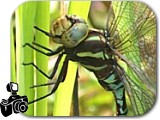 After
mating, in some species the male will hold onto the female
and the pair will fly around together as the female lays
her eggs. In others the male may release the female, but
guards her from other males while she is laying eggs. Sometimes
the female lays eggs alone. After
mating, in some species the male will hold onto the female
and the pair will fly around together as the female lays
her eggs. In others the male may release the female, but
guards her from other males while she is laying eggs. Sometimes
the female lays eggs alone.
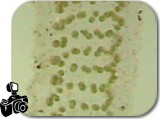 Some
females lay eggs simply by dropping them into water. Other
species lay egg-filled strings of jelly in water. Some have
an ovipositor, a needle-like tip on the abdomen, and will
insert eggs into aquatic plant stems or even into damp ground
near water. A female may lay several batches of eggs over
her life time, totalling several thousand eggs. Some
females lay eggs simply by dropping them into water. Other
species lay egg-filled strings of jelly in water. Some have
an ovipositor, a needle-like tip on the abdomen, and will
insert eggs into aquatic plant stems or even into damp ground
near water. A female may lay several batches of eggs over
her life time, totalling several thousand eggs.
 Egg
laying. Egg
laying.
(Video = 0:55, 4.3 Mb.)
|
| |
(Watch a higher resolution version of this video on YouTube. Click Here: Egg Laying!) |
|

Fly back to NatureNorth.com |